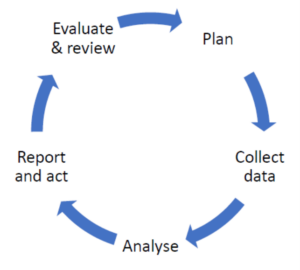Analyse, report and respond
This is the most important step – data is useless unless it’s acted upon. There are so many examples of surveys and feedback that is gathered regularly but then goes unused. The purpose of understanding your audiences is to be able to make better decisions, use your resources more effectively, be more focused in your work, so it is key to put all of your effort and participants’ time to good use.
The data you’ve gathered might be a little overwhelming in its raw state. This is where asking the right questions becomes so valuable in relating responses back to your research questions. Organise the data responses you have against the research questions you posed in your plan. The data should provide evidence under each of these.
One method that can be useful in analysing data is to focus on what stops people from using your service (‘barriers’) and what encourages them to do so (‘drivers’). If you have a lot of open responses from discussions, identify key points under these headings, clustering similar points together to form headlines. You can then consider how you might respond to each of these headline points. An example of this is shown below.
Barrier: A lack of awareness of the service
Response: Review marketing
Barrier: Opening times too restrictive
Response: Consider evening or weekend opening
Driver: Ability to browse collections
Response: Collection topics and catalogue available online
Driver: More relevance to young lives today
Response: Work with young advisory group to develop programmes
Most people prefer to write up a report or presentation of findings. Use a format that works for your organisation and your audience. You can use graphs and visuals if appropriate, anything that makes it easy to read. Do make sure you give clear context for the research so anyone reading the report can grasp its relevance and scope. Be clear about the methods used, include timeframes and a short profile of who the participants were. For example:
“This research was carried out across Spring 2023 with a group of teachers in xx area who had never used our service before. An online survey was followed up by a focus group with secondary school history teachers.”
Having presented your findings against your research questions, you may want to identify options or recommendations for actions. You could also identify any follow-up actions needed. Make sure you get approval and decisions on these actions from your appropriate authority – be it line manager, Board, Committee. Do emphasise that these actions are based on evidence from your potential users and that this has been part of a process that you will now review and then return to as you continue to develop your plans.
Evaluation and sustainability
 This is the final stage of the cycle, as you review the process you’ve been through and evaluate how it’s worked.
This is the final stage of the cycle, as you review the process you’ve been through and evaluate how it’s worked.
Think about what’s worked well and, comparatively, less well.
Consider:
- The research questions
- The methods/tools you used
- The recruitment and contacts you made
- The analysis and reporting
- The resources you used – time, budget, places, etc.
- Ask yourself what you’d do differently next time
Even just spending half an hour with a flip chart with those questions on and jotting down quick responses on post-its under each heading can be really useful. Make a note of your responses and use this for future planning. Maybe you could share that thinking with your colleagues so you share out the learning from this process.
In sharing the value of this process with your colleagues, it should prompt you to consider how to do this on a regular basis so that it becomes embedded in your organisation’s culture. You might decide to have a standing item on a Management team or Board agenda to review data and reflect on responding to patterns and trends over time. This might mean improving the data you regularly collect to make it more useful to decision-making. It could be that you decide to include regular audience consultation in job descriptions or identify training to share the skills needed across the team.